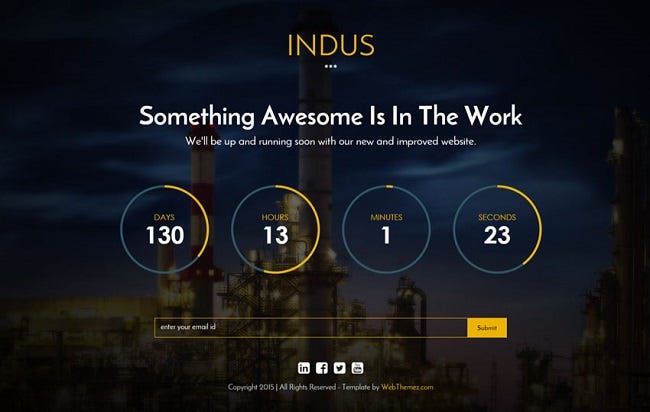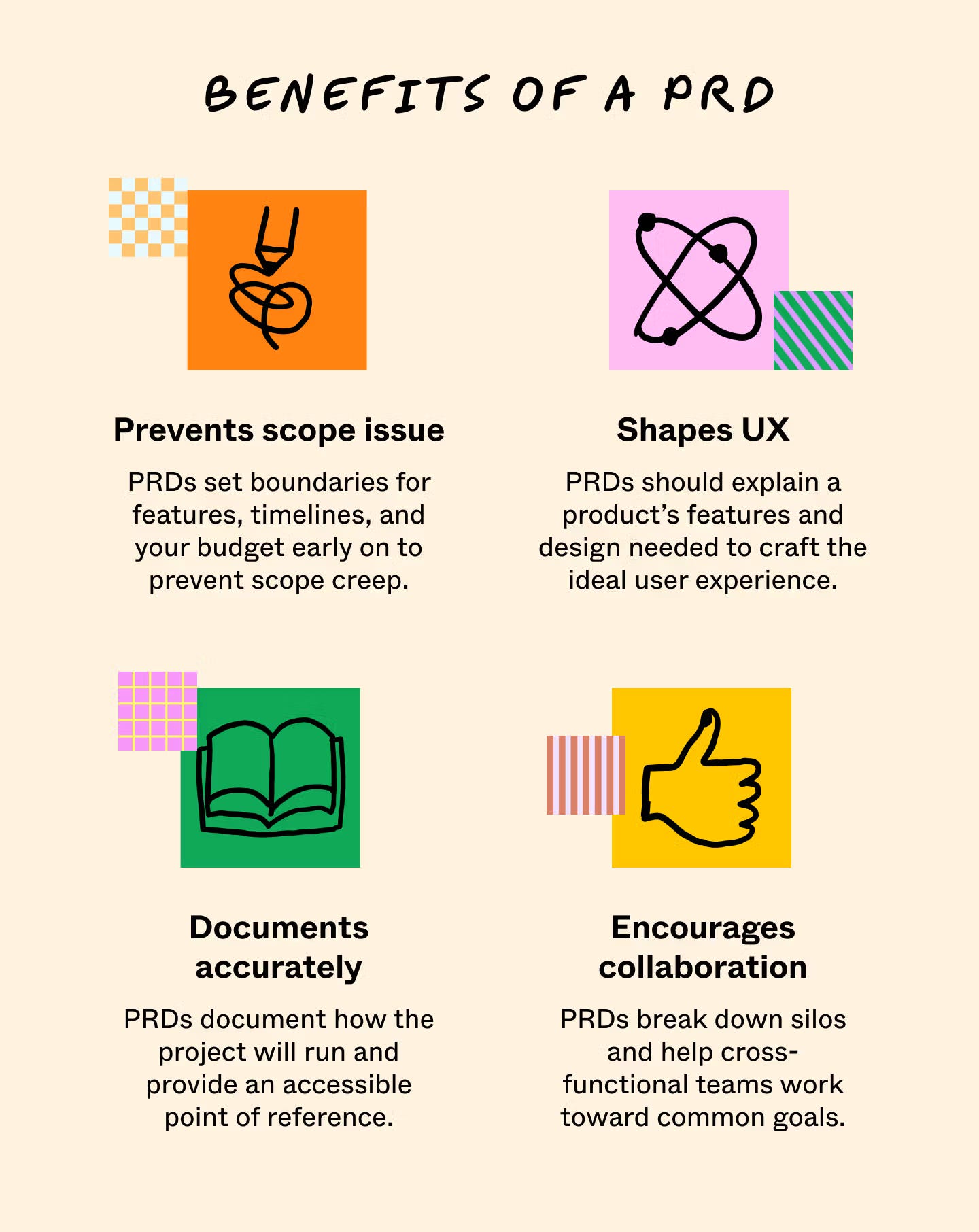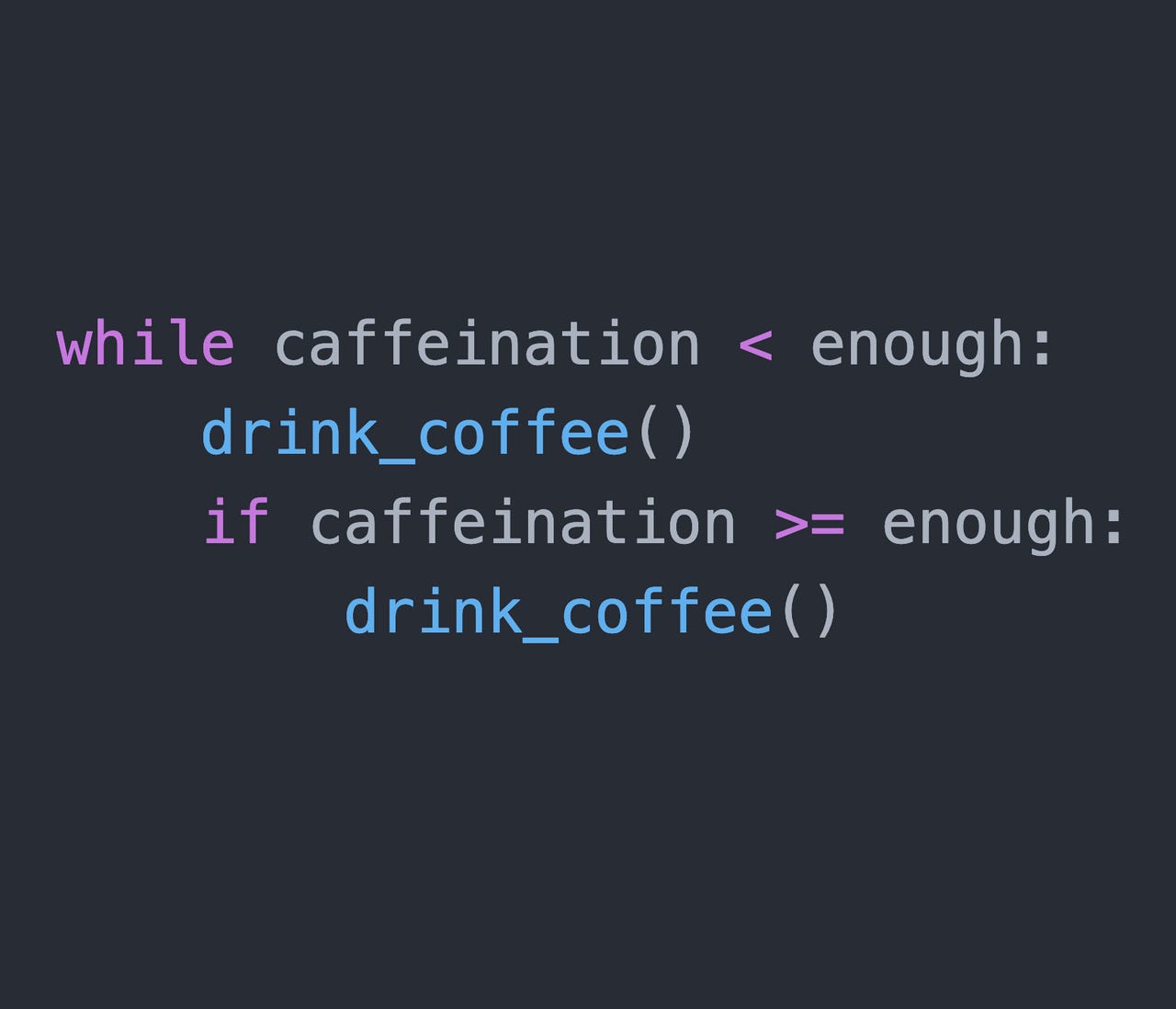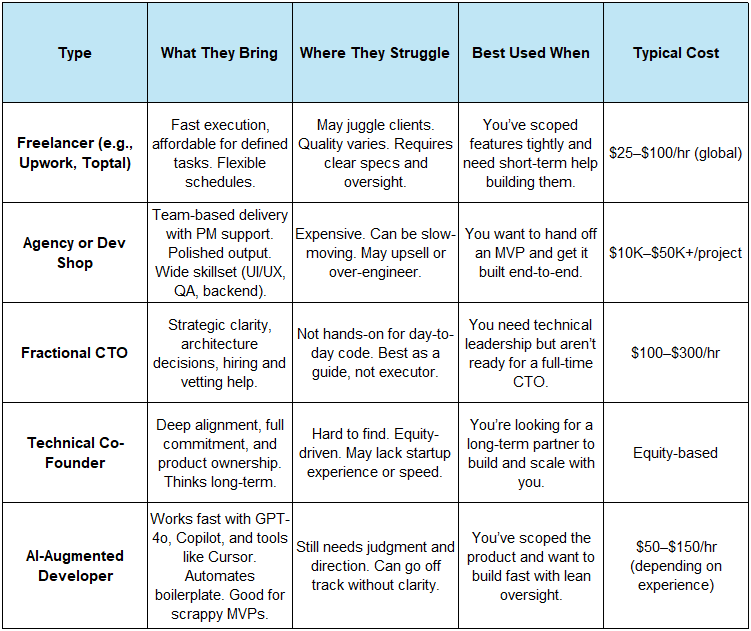How Non-Technical Founders Can Hire Great Developers
Founder OS: The definitive playbook for non-technical founders hiring, vetting, and working with developers in the AI-native era.
You’ve got the idea. You can picture the product. But when it comes to actually building it, you’re stuck.
No code skills.
No tech co-founder.
Just a Notion doc, a few Loom videos, and a gut-level belief that this thing will work.
That’s the exact spot where thousands of founders find themselves stuck every day. And right now, it’s gotten way more complicated than ever.
Today, you're not just choosing between a frontend or backend dev. You're actually threading through a minefield full of AI-assisted developers, no-code tools, fractional CTOs, and global talent marketplaces that didn’t exist a decade ago.
Most of the advice online was written before GPT-4o, before Cursor, before solo devs started shipping full SaaS products in a weekend’s work.
70% of founders hiring tech talent are doing it for the first time, and often using advice written before AI, no-code, or global freelance marketplaces even existed.
This is an urgent issue. And this guide is built for right now.
Not for founders in theory. For founders in motion.
It doesn’t assume you need to write code. But it does assume you need to lead. And that your real job isn’t to build an app, it’s to build traction.
In this article, we’ll walk through how to do that. How to scope clearly, hire smartly, vet without guessing, and build systems that make developers thrive, without getting lost in tech you don’t understand.
You don’t need to become an engineer. You just need to act like a founder who knows what great looks like.
Table of Contents
1. Rethink What 'Hiring a Developer' Actually Means in 2025
2. Get Clarity First: What to Write Before You Hire
3. Know Your Options: Who You Can Hire in 2025
4. How to Vet Developers (Even If You Don’t Understand Code)
5. Set Up a System, Not Just a Developer
6. Common Mistakes to Avoid (Still Relevant in 2025)
7. Final Advice: You’re Hiring for Traction, Not Code
1. Rethink What 'Hiring a Developer' Actually Means in 2025
If you think hiring a developer means finding “someone who can code it up,” you are on the wrong path.
In 2025, building doesn't always start with hiring. It starts with scoping. With validating. With asking: “What’s the fastest, leanest way to prove this product matters?”
That might involve a traditional developer. But not always.
Today’s toolkit is wider than ever:
Some founders are shipping MVPs with no-code tools like Glide, Bubble, or Softr; no dev needed.
Others are using AI-assisted workflows (Cursor, GPT-4o, Copilot) to co-build with smaller dev teams or even solo.
You also have fractional CTOs, productized agencies, and global freelancers who can deliver specific modules without owning the whole stack.
What you’re really doing isn’t hiring “a coder.”
You are deciding the path that will prove that your product has legs.
Sometimes that means spinning up a Typeform and landing page before writing a single line of code. Sometimes it means a visual prototype in Figma. Sometimes it means building a wizard-of-oz backend that runs on Airtable and Zapier until you have users.

Hiring a developer too early, that is before you’ve clarified the core use case, user flow, and constraints, is one of the most common and expensive mistakes founders make.
Don’t outsource your clarity.
The best time to hire is when you are seeking momentum. But before that, get clear on what you're testing, who you're serving, and whether a line of code even needs to be written.
You don’t need someone who just follows instructions. You need a person who knows when to push back, to ask better questions and help you build the right thing.
But they can only do that if you’ve done your part first.
2. Get Clarity First: What to Write Before You Hire
Before you hire anyone, get your idea out of your head and into a form someone else can build from.
You don’t need a 10-page Product Requirement Document (PRD). Not a bloated Notion doc. And definitely not a whitepaper.
All you need is a clear, sharp product one-pager.
Your one-pager is your startup’s blueprint. It won’t include every feature or flow, but it should answer five critical questions your developer (and your future self) will need:
What does the product do? (User POV)
Describe the product from the user’s perspective, not your vision deck.
“A tool that allows a freelancer to send clients a branded invoice in 60 seconds, directly from their phone.”
Keep it functional. Use plain language. Imagine you're narrating what someone can actually do on day one.
What are the core features?
List the 3–5 features that must exist in the MVP. Not the roadmap, not the wishlist, just what’s essential to get real users using it.
Create account → Upload invoice logo → Select amount and currency → Auto-generate PDF → Share via link or email.
If you can’t prioritize features, you’re not ready to build. And if everything feels essential, you’re probably still in brainstorm mode.
What are the tech assumptions?
List any functional needs that affect how the thing gets built:
Does it require login/authentication?
Will it need location access, image uploads, real-time updates?
Mobile-only? Web? Both?
Any must-have integrations (e.g., Stripe, Google Calendar)?
Even if you’re not sure about the tech stack, outlining such assumptions helps the developer make smart architecture choices, and identify any headaches early on.
A good developer will build off your initial one-pager, not follow it blindly.
What are the business constraints?
Spell out your limits. Budget, timeline, launch goals, platform preferences. Be honest. Allow for a margin of error.
“I have $5K to spend now. I’d like to launch a testable MVP in 6 weeks. Desktop-first is okay.”
No one builds well with moving goalposts. Clarity here keeps devs aligned and projects sane.
[Maybe picture of a shopping list or something]
If you want to go one step further, feel free to use tools like Figma, Whimsical, or Loom to visually sketch flows, mock up screens, or narrate your product thinking.
Founders who show, even roughly, what they want built reduce scope confusion by half.
If you can’t describe your product clearly and visually, you’re not ready to build it.

3. Know Your Options: Who You Can Hire in 2025
Hiring a developer isn’t about finding someone who can follow instructions. It’s about finding someone who can think with you. Someone who knows when to ask, when to push back, and when to build fast without getting caught up in the details.
The best early-stage developers are comfortable with ambiguity. They understand MVP thinking. And they don’t just code, they shape the product with you.
In 2025, your hiring options have multiplied. Here’s how they stack up.
Developer Archetypes for Early-Stage Founders (2025 Edition)
Don’t think of the above as just roles. They are different approaches to solving different problems.
The right choice depends on where you are right now. Do you need raw speed? Strategic thinking? Polish? Someone who'll stick around for the long haul?
One mistake many founders make is hiring for convenience instead of capability. A developer who only executes will stall sooner or later.
And in early-stage startups, things are always messy. You want someone who can think alongside you, even if they're only with you for the first stretch of the journey.
4. How to Vet Developers (Even If You Don’t Understand Code)
If you're not technical, traditional hiring methods will fail you.
The truth is that you can’t tell a great developer from a mediocre one just by looking at their CV or their GitHub. Portfolios are hard to dissect and interviews rarely paint the full picture.
When you don’t speak the language of code, you need a different filter, one that tests how someone actually works, not just what they say.
That filter is a trial project. It doesn’t have to be a coding quiz or a whiteboard puzzle.
What it needs to be is a short, paid, real-world task that reveals how the developer communicates, executes, and collaborates.
What to Test (and Why It Works)
A good trial project lasts 4-8 hours and mimics the kind of work they’ll actually do. You’re not looking for pixel-perfect UI or brilliant algorithms. You’re looking for signal across three fronts:
Communication: Do they ask clarifying questions before starting? Do they update you if something’s unclear? Do they explain tradeoffs after the task is done?
Execution: Did they actually deliver what was asked, on time, and in usable form?
Collaboration style: Did they follow instructions without being robotic? Did they propose improvements? Did they feel like a partner or just a task-taker?
This is the closest proxy to working together, and you’ll learn more in a week than in five rounds of interviews.
What a Great Trial Project Looks Like
A great trial project is scoped but meaningful. It could look something like this:
“Build a simple form where users can sign up, confirm via email, and get redirected to a dashboard. No need for styling, just basic UX and clean flow.”
Give written instructions and maybe even a Loom explainer. Set a deadline. Pay for their time. This is a mutual tryout and not a free test.
But the real work happens by observing their behavior. Who asks smart questions early? Who communicates clearly, hits the mark, and documents what they did?
That’s the decision maker.
Red Flags to Watch Closely
Even in short projects you have to be extra careful. Things to look out for:
🚩AI-plagiarized code: If the code is copy-pasted from StackOverflow or ChatGPT without understanding, they won’t be able to explain it back to you. Ask: “Can you walk me through how this works?” and listen for clarity or fumbling.
🚩 Fake portfolios: If their resume includes impressive builds, ask for a screen-share walkthrough. Real devs know every corner of what they built. Fakes dodge details.
🚩 Poor async habits: If someone disappears for days, misses the spec, or ghost-replies with “done,” assume that’s how they’ll operate post-hire. Communication is culture.
Bring in a Fractional CTO (Yes, Even for Vetting)
Here’s the thing most founders forget: you don’t have to make this decision alone.
Instead, you can bring in someone who speaks fluent code to look over your shoulder. A fractional CTO, senior developer, or technical consultant, can review trial projects or sit in on final interviews.
This doesn’t have to be expensive or long-term. Many experienced engineers are happy to consult part-time, review code, or sit in on a Zoom call for an honorarium or hourly rate.
They can spot problems you can’t, like:
Poor code structure or unreadable logic
Solutions that are way more complex than they need to be
Obvious security or performance issues
Overengineering or copycat behavior
Even a 30-minute review call after the trial project can save you weeks of bad hires.
You don’t need to understand code. But you do need to surround yourself with people who do, at least until you find someone who earns your trust.

5. Set Up a System, Not Just a Developer
Now here’s where it gets tricky. Getting someone hired is the easy part.
Because unless you set up a system around them, you’ll burn weeks on misalignment, rework, and silence.
Most non-technical founders think their job ends once a dev joins. In reality, that’s when your real job begins.
You need to create an environment where your developer can actually get things done. You don’t have to manage lines of code, but you do need to manage clarity, pace, and flow.
Build the Loop Before You Build the Product
A lean product system doesn’t require fancy tools. But it does require structure.
Think of it like this: You need one place to write down what’s being built and why. That could be a Notion doc or a Google Doc, whatever helps you articulate the current sprint, user flows, and product goals.
You also need a way to show, not just tell. To demonstrate your vision. Founders who share a rough Figma wireframe or record a 2-minute Loom walkthrough remove 80% of ambiguity before the first line of code is written.
Then there’s execution rhythm. A Trello board or Linear workspace gives your developer a visible to-do list, a sense of progress, and a place to raise blockers.
Combine that with async messaging like Slack, Discord, or whatever tool suits your workflow, and you’ve got the scaffolding for smooth, high-velocity collaboration.
These tools become your operating system as a founder.
What Founder-Led Product Management Actually Looks Like
You don’t need to be technical to lead product. You just need to be consistent.
Let’s say you’re kicking off a sprint. You write out the feature goal in Notion. You open Loom and explain the user problem in plain English. You highlight what hurts, why it matters, and what outcome you’re aiming for.
Then you drop a link to a Figma file with two rough wireframes and tag your developer in Linear to pick it up. Midweek, they hit a question. You respond within the hour. By Friday, you’re reviewing a working feature together on a Zoom or staging link.
Feedback is clear, decisions are quick, and the next sprint rolls forward without drama.
No endless meetings. No PM hire. Just operational clarity.
Clarity Equals Speed
Most early-stage devs don’t fail because they’re slow. They fail because they’re guessing.
When you give your developer clean inputs, they move faster. When you give them feedback on time, they iterate faster. When you document decisions, even loosely, they stop building in the dark.
At the end of the day you’re not managing code. You’re managing clarity and velocity.
And that’s how real products get launched.
6. Mistakes to Avoid (Still Relevant in 2025)
You’d think with all the playbooks floating around, founders would stop making the same early mistakes. But no matter how advanced tech stacks get, no matter how much AI changes the game, these classics are still alive and well, and still costing founders time, trust, and traction.
Hiring Too Early
If you haven’t talked to users, scoped your MVP, or figured out what problem you’re solving, you’re simply not ready to hire.
Too many founders bring on a dev to “figure it out together.” That usually ends in wasted time and a confused product. When you hire before you have clarity, you're basically asking someone else to solve the problems you haven't solved yourself.
Trying to Build Everything at Once
Every early-stage idea feels like it needs ten features. Resist it.
Feature bloat kills momentum.
You don’t need onboarding, dashboards, notifications, and integrations on day one.
You need one clean path that solves one real pain. Everything else can wait.
In early-stage startups, focus becomes your most important competitive advantage.
Not Paying for Early Work or Tests
Expecting free trial tasks or unpaid contributions is a fast way to repel great talent. If you want a developer to take your product seriously, start by respecting their time.
A paid 4-8 hour test project is a filter, not a cost. And it tells the right devs: you play fair.
Assuming Developers Are Product People
Some are. Most aren’t. Your job is to define the “what” and “why.” Their job is to implement the “how.”
Don’t assume your developer will question bad ideas, suggest UX changes, or prioritize features for you. That’s your responsibility until you hire someone explicitly to own the product.
Managing Like a Boss, Not a Partner
Early-stage devs shouldn’t be seen as employees. They’re collaborators.
Micromanagement kills motivation. Vagueness kills velocity.
The sweet spot is structure with autonomy: define the goal, share the context, and trust them to figure out the implementation.

If your dev is guessing what matters or waiting on your feedback, you’re slowing the entire company down.
7. Final Advice: You’re Hiring for Traction, Not Code
It’s easy to get caught up in resumes, repos, and the pursuit of “clean code.” But that’s not the game you’re playing.
You’re not here to build something elegant. You’re here to build something that moves, something that gets in front of users, gets feedback, and gets better fast.
That’s what great non-technical founders do. They don’t try to become engineers. They don’t obsess over frameworks. They focus on the system: tight specs, fast feedback, consistent loops.
They remove blockers. They communicate clearly. They treat product like motion, not perfection.
Your job isn’t to chase clean code but to chase momentum, feedback, and proof.
So here’s the mindset to keep:
Before you hire, ask: what’s the fastest way to prove this matters to users?
Then build just enough to do that. And do it well.
Read more from Founders Corner:
CEO-Level Strategies for Confident Negotiation
How to Delegate Like a Founder CEO
Co-Founder Conflict 101: Should You Stay Together or Part Ways?







Great guide....I really like the options you have shown here...
I love your statement don’t over source your clarity 👌